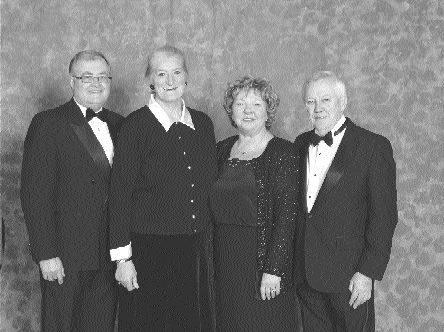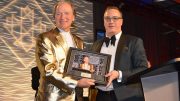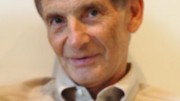The newest inductees into the Canadian Mining Hall of Fame served their companies in widely differing roles, from explorer to developer to deal maker, but all four men proved to be invaluable contributors both to their companies and to the Canadian mining industry.
This year’s four inductees were honoured at the 16th annual induction ceremony and dinner, held in mid-January at Toronto’s Royal York Hotel before a record crowd of more than 620 people.
“Probably we are living in the best of times for our industry,” said Master of Ceremonies Pierre Lassonde, president of Newmont Mining, in his opening address. “One analyst has pointed out that in 2002, the gold price started with a “2,” in 2003, gold started with a “3,” and this year it started with a “4.” I think the audience knows where I’m going with this.”
Geologist Michael J. Knuckey (b. 1936) was inducted in recognition of his leadership in the discovery or development of at least 10 mineral deposits, of which two, Collahuasi and Raglan, are major. In addition to those, six have become mines: Corbet, Ansil, Winston Lake, Samatosum, Thayer Lindsley and Ujina.
Born in Cornwall, England, Knuckey graduated in mining geology from London’s Royal School of Mines and emigrated to Canada in 1957. He worked throughout eastern Canada, then joined Falconbridge as chief geologist at La Luz Mines in Nicaragua. Following post-graduate studies in the U.K., he rejoined Falconbridge and worked his way up to vice-president of exploration in 1986.
In 1995, with Noranda gradually taking over Falconbridge, Knuckey became president and CEO of Noranda Mining & Exploration, and then, two years later, executive vice-president of exploration and project development.
Knuckey’s financial and intellectual support of new exploration technologies allowed them to become widely used. These include litho-geochemistry, borehole electro-magnetic geophysics, Megatem airborne surveys, and 3-D seismic surveys.
Howard Stockford, president of the Canadian Institute of Mining, Metallurgy and Petroleum and executive vice-president of Aur Resources, presented Knuckey with his award and said there were four words he felt applied to Knuckey: “mentor,” “discoverer,” “perseverance” and “friend.”
Stockford recounted how, many years ago, his young wife lost her wedding band in the sand under two feet of water while swimming at a beach in Val d’Or, Que. Knuckey was there, too, and he promptly organized everyone at the beach to fan out and systematically sift through the entire beach area. The ring was found.
“It was typical of the way the man works,” said Stockford. “He is one of the best examples of someone with a nose for ore that I know of.”
In his acceptance speech, Knuckey said he’d been “extremely fortunate over most of my life — so much so, that my name probably should have been ‘Lucky’ rather than Knuckey. I’ve always had wonderfully talented people to work with and great mentors to guide me.”
He paid tribute to his wife and family, who followed him as his career took him from Toronto to Elliott Lake, Malartic, Coniagas, Nicaragua and finally back to Oakville — all in the space of 20 years.
“Each place offered its own special, personal challenges,” said Knuckey. He recalled how a group of drunken lumberjacks once rescued his wife and newborn after their car ran out of gas on a lonely, winter road in northern Quebec, and how some of his employees in Nicaragua turned out to be Sandinista guerrillas.
He said the challenges at Falconbridge were “much tougher” and that the “real prizes were how to make Raglan and Collahuasi economically attractive.”
Transportation was the key at Raglan in northernmost Quebec, and Knuckey’s group put up three-quarters of a million dollars of their precious exploration budget to fund an experimental voyage by boat into Deception Bay in winter.
“I tell you, it was nail-biting times, but the ship made it through the ice,” said Knuckey. They had secured at least a 9-month shipping season and so were able to focus on increasing reserves and negotiating an impact-and-benefits agreement with the local Inuit.
With Collahuasi in Chile, he said it was a “very tough sell” to get Falconbridge’s partner, Anglo American, which was farming in at the time, to abandon its unsuccessful, underground, high-grade vein project in favour of a property-wide exploration program that led to the discovery of a large porphyry.
Knuckey concluded by saying that two things have given him a great deal of satisfaction over the years: “The first is to see a discovery into production, providing jobs and creating wealth for everyone, and the second is to see many of my former colleagues move on to senior positions in both major and junior companies.”
The next inductee was West Coast mining engineer Walter J. Riva, who was born in 1922 in coal country in Canmore, Alta., and rose to become an unmatched leader of Canada’s coal-mining industry.
After serving with the Royal Canadian Air Force during the Second World War, Riva became a labourer at Canmore Mines while studying mining engineering at the University of Alberta. He graduated in 1949 and joined Canmore full-time, eventually becoming executive vice-president and CEO.
Riva moved to Denison Mines, and then to Kaiser Resources, where he worked his way up to president of the coal division. When Kaiser was acquired by British Columbia Resources Investment Corp. in 1980, Riva became president and CEO, then chairman and CEO.
In 1983, he left management to serve as vice-chairman of Westar Mining, and then chairman of B.C. Resources, until his retirement in 1986.
Riva is credited with helping transform Western Canada’s coal industry from a provincial business struggling for survival into a dynamic, internationally competitive industry. He did this by introducing new technology and mining procedures, developing new markets such as Asia, and improving corporate governance.
Gary Livingston, president of the Coal Association of British Columbia, introduced Riva by saying he felt he was the “messenger on behalf of the thousands of people who, like me, worked for Walter Riva at one time or another: Walter, we’ve all known your wisdom, have been led by your integrity, and have experienced your generosity and kind spirit.”
Livingston noted that Riva has lived a balanced life: “His family has been his number-one priority, and his passion for golf is legendary: how many people do you know go out and build their own golf course so they can reduce their handicap?”
Fumbling at first with the too-high microphone, the compact Riva quipped, “I used to hear so many speakers ask, ‘Can you hear me?’ Well, I’ve always had to ask, ‘Can you see me?'”
Riva said that getting admitted to the Canadian Mining Hall of Fame was “certainly one of the nicest and most-appreciated things that’s happened to me in my life.”
Echoing Knuckey, he said he felt lucky in many ways: “First of all, to have been born a Canadian and to have been born and raised in a small mining town — it was a real advantage. I was also lucky to have made it through the Depression and the war.
“I was especially lucky to have worked with such great people, from the bottom up to the top — people at the bottom with tremendous intelligence, albeit little education, who shared that knowledge and expertise with me and anybody else who was around. They were industrious and creative.”
Riva said that throughout all levels of manpower, he “scraped off a little bit of knowledge. Each one had something to teach, and I happily took advantage of that. So this award is not just mine; I share it with all the people who helped me along the way.”
Riva recalled one of his earliest jobs as a young engineer in the 1950s, when coal producers were struggling to find new markets. He was sent out to Canadian Pacific to convince the company it should should use coal in its railroad engines instead of oil. To demonstrate coal’s power, he got on a Winnipeg-to-Kenora train with a railroad engineer.
“We moved along quite well for an hour or so, and then the engine started to run down and we eventually stopped; we couldn’t produce steam with our coal anymore,” said Riva.
So, the fireman, the engineer and Riva climbed out and started to strip slats of wood off a snow fence beside the tracks until the engine could produce steam again. “Once we arrived at our destination, the fireman looked at me and said, ‘Hey kid, is this your coal?’
“I said, ‘Yes, sir.’ And he said, ‘what the hell do you call it? Asbestos?'”
Riva added that his company came up with an alternative plan that did succeed.
He also paid tribute to his wife, who raised six children, fed and entertained his business associates all over the world, and “even posed as a geisha in Japan — and was quite successful.”
Said Riva: “You all recognize how important a supportive family is in an industry like ours, where there are booms and busts, and the busts aren’t always so easy to negotiate.”
The next inductee, Edgar A. Scholz (1915-1980), was a pioneer in applying large-scale, open-pit mining methods to low-grade copper, molybdenum and gold deposits, much to the benefit of his employer, Placer Development Limited (now Placer Dome).
Born in Sand Coulee, Mont., Scholz began his working life as a miner in Butte and then, in 1941, earned a bachelor of science degree in geological engineering from the Montana School of Mines.
After more than a decade managing several small mines in Montana and Arizona, Scholz joined a Placer subsidiary in San Francisco in 1956 as senior exploration geologist, later becoming vice-president and director.
In 1961, he transferred to head office in Vancouver, becoming vice-president of exploration by 1965.
Over the years with Placer, Scholz was involved in numerous low-grade, high-tonnage mining projects, including Marcopper, Craigmont, Endako, Gibraltar Mines, McDermott, Cortez, Golden Sunlight, Kidston, Porgera and Misima.
Guiding his efforts was an unwavering belief, even in the 1950s, that the price of gold would eventually rise dramatically, and that Placer should position itself accordingly.
Scholz retired from Placer in 1976 and established Scholz International Mining, a consulting firm. He was instrumental in the formation of Pegasus Gold Mines, whose early success was built on his knowledge of the extremely low-grade gold deposits at Zortman and Landusky in Montana, near his birthplace.
Dale Scholz, president and CEO of Oremex Resources, accepted the award on behalf of his father. Also present were Ed Scholz’s son, Henry (an Oremex director, too), and daughter Karli.
“Dad would have been extremely proud and honoured by his induction,” said Dale. “He believed that Canadian mining was not only a world leader, but was the world leader.”
In presenting the award, Placer Dome Chairman Robert Franklin commented that “Ed was very, very important to the history of Placer Dome. He was a visionary who had an uncanny ability to recognize opportunities to take low-grade orebodies and mine them in a profitable way. His skills have made our company what it is today.”
Franklin told a tale about one of Ed Scholz’s small, bootstrap mines in 1953 in Bagdad, Arizona, where his wife and others worked pushing mine cars.
Regrettably, Mrs. Scholz (who is still alive but was not present at the ceremony) was badly injured in a horrible accident, in which she fell down an ore shoot. Her leg was severed at the ankle, and the doctor came and suggested that the foot would have to be amputated.
“Ed said to the doctor, ‘If you do that, I’m going to knock you out. Fix the leg!'”
So, the doctor went back to the operating room, sewed the foot back on, put the pins in, and Mrs. Scholz is still using that foot today.
“It’s a tribute to the man’s vision,” said Franklin.
For his part, Dale recounted his boyhood in Bagdad: “It was the end of the road, out in the Arizona desert. You didn’t go through Bagdad; if you got to Bagdad, it was either because you got lost or you intended to be there.”
He described how, one afternoon, a rattlesnake showed up in the yard where Ed had put up a basketball backboard for his children.
“The neighbours came over and killed it, but mother was quite upset,” said Dale. “By that time, Dad had come home and mother had started into him about the rattlesnake and all the horrible things that could have happened to the children.
“Eventually she slowed down and took a breath, and Dad said, ‘well, honey, the quick and smart ones we’ll keep, and the rest we’re just going to have to let go.'”
The evening’s final inductee, mining executive Dr. Norman B. Keevil (b. 1938), joined his father Norman Bell Keevil Sr. (1910-1989) in the Hall of Fame — only the second father-son combination after the two William Jameses.
Born in Cambridge, Mass., where his Saskatoon-born father was undertaking research at Harvard, Keevil obtained a B.A.Sc. in applied geology from the University of Toronto in 1959 and a doctorate from the University of California (Berkeley) in 1964.
He joined his father’s company, Teck, in 1962, becoming president and CEO in 1981. Keevil became chairman and CEO in 2000, and then non-executive chairman in 2001.
Teck started its corporate life with a few small gold mines in Ontario and Quebec. Thirty years ago, its revenues were $11 million, mainly from oil, and its assets amounted to $48 million.
Under Keevil’s guiding hand, Teck carried out a string of beneficial amalgamations and mergers, and moved its headquarters to Vancouver from Toronto. In time, the company evolved to become the diversified mining giant we know today as Teck Cominco, boasting revenues in 2002 of more than $2 billion and assets exceeding $5 billion. The company profitably mines gold, base metals and coal in Canada, the U.S. and Peru, and refines metals in Canada and Peru. It ranks as the world’s largest zinc miner.
Keevil has again and again showed his shrewdness by manoeuvring Teck into a key player in the development of several high-profile deposits, including Voisey’s Bay, Hemlo, Antamina, and the coal fields of northeastern British Columbia.
In presenting the award, Teck Cominco President David Thompson heaped praise on his boss: “Norm has been an inspiration to all of us who work at Teck Cominco, and he has given real help to many people in our industry.
“Norm has always believed that our industry should have a vital and thriving junior sector,” he continued, noting the many ways Keevil had quietly contributed — assisting young geologists getting started in the industry, helping experienced promoters who had fallen on hard times make a comeback, providing seed capital for exploration plays, and even giving out personal loans.
“And Norm has been delighted when they’ve succeeded, whether or not it’s made any direct benefit for our company,” said Thompson. “He believes that these players will bring us more opportunities in the future and that we’ll get our fair share.”
Thompson recalled that when he first started at the company and began negotiating deals, Keevil would tell him, ‘Always leave something on the table.’
“That’s something I found rather difficult,” laughed Thompson. “But he’s right: if the deal works, you can afford it; if it fails, your partner believes you are generous and will probably come back with more deals in the future.”
In taking the stage, Keevil said that he “couldn’t even begin to say what a pleasure it is to receive this award. I never expected it, and it overwhelms me.”
He said that “ore reserves are critical for a mining company — a mining company without reserves is an oxymoron. But it’s the people that make it happen in this business. There’s a lot of work that goes into discovering and making a mine.”
He pointed out that, in a mining company, “it’s an optimist, tempered by realism, who joins forces with a realist who can also see opportunity. That combination is what makes Canadians world leaders in mining.”
With the addition of Knuckey, Riva, Scholz and Keevil, the Canadian Mining Hall of Fame expands to 108 members, whose biographies can be found at www.HallofFame.mining.ca
The Hall is situated on the ground floor of the mining building at the University of Toronto; it also forms part of the Mining Museum in the Lester B. Pearson Civic Centre in Elliot Lake, Ont.
The Hall has four main sponsors: the CIM, the Mining Association of Canada, the Prospectors & Developers Association of Canada, and The Northern Miner.
A board of directors, comprising 12 members appointed by the four sponsors, conducts the business of the Hall of Fame.




Be the first to comment on "Canadian Mining Hall of Fame welcomes four new members"